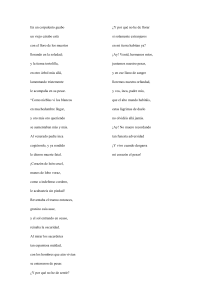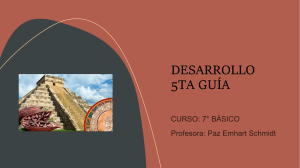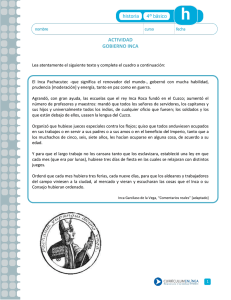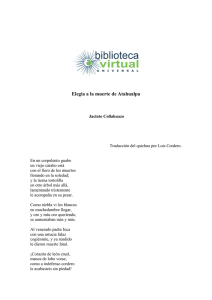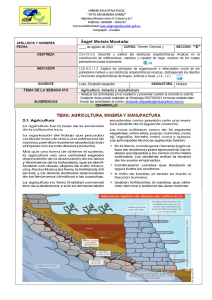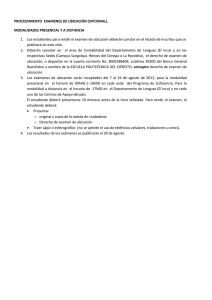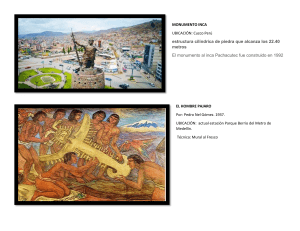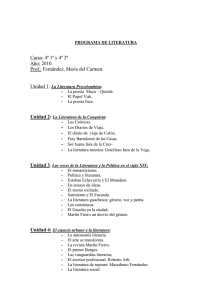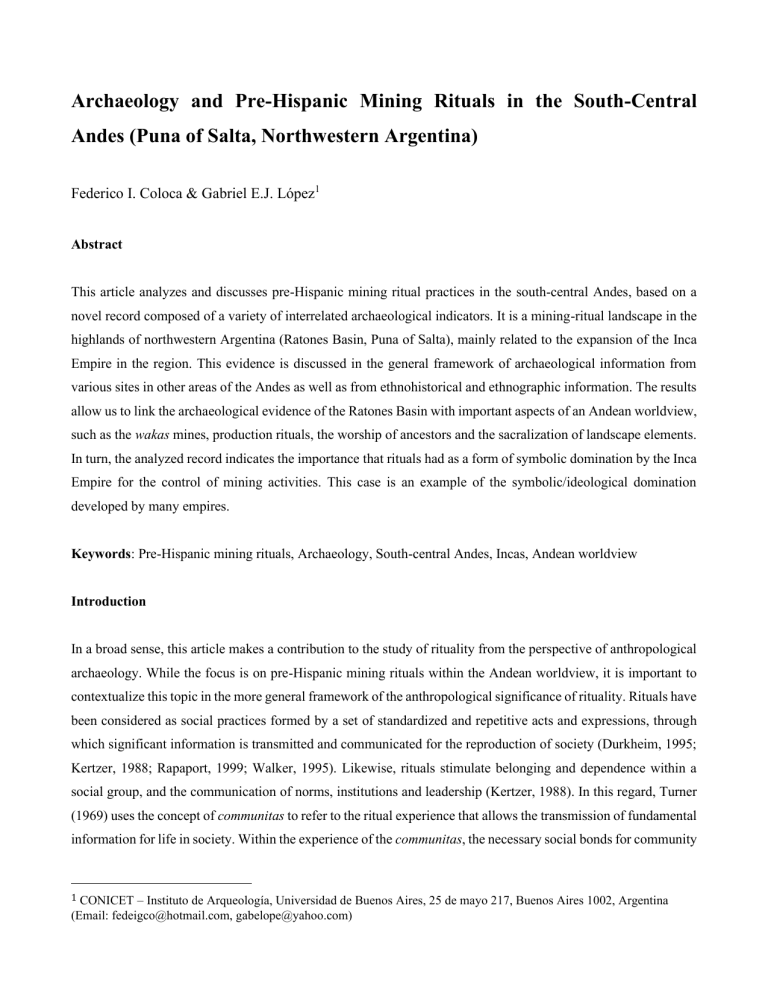
Archaeology and Pre-Hispanic Mining Rituals in the South-Central Andes (Puna of Salta, Northwestern Argentina) Federico I. Coloca & Gabriel E.J. López1 Abstract This article analyzes and discusses pre-Hispanic mining ritual practices in the south-central Andes, based on a novel record composed of a variety of interrelated archaeological indicators. It is a mining-ritual landscape in the highlands of northwestern Argentina (Ratones Basin, Puna of Salta), mainly related to the expansion of the Inca Empire in the region. This evidence is discussed in the general framework of archaeological information from various sites in other areas of the Andes as well as from ethnohistorical and ethnographic information. The results allow us to link the archaeological evidence of the Ratones Basin with important aspects of an Andean worldview, such as the wakas mines, production rituals, the worship of ancestors and the sacralization of landscape elements. In turn, the analyzed record indicates the importance that rituals had as a form of symbolic domination by the Inca Empire for the control of mining activities. This case is an example of the symbolic/ideological domination developed by many empires. Keywords: Pre-Hispanic mining rituals, Archaeology, South-central Andes, Incas, Andean worldview Introduction In a broad sense, this article makes a contribution to the study of rituality from the perspective of anthropological archaeology. While the focus is on pre-Hispanic mining rituals within the Andean worldview, it is important to contextualize this topic in the more general framework of the anthropological significance of rituality. Rituals have been considered as social practices formed by a set of standardized and repetitive acts and expressions, through which significant information is transmitted and communicated for the reproduction of society (Durkheim, 1995; Kertzer, 1988; Rapaport, 1999; Walker, 1995). Likewise, rituals stimulate belonging and dependence within a social group, and the communication of norms, institutions and leadership (Kertzer, 1988). In this regard, Turner (1969) uses the concept of communitas to refer to the ritual experience that allows the transmission of fundamental information for life in society. Within the experience of the communitas, the necessary social bonds for community 1 CONICET – Instituto de Arqueología, Universidad de Buenos Aires, 25 de mayo 217, Buenos Aires 1002, Argentina (Email: [email protected], [email protected]) cohesion are reinforced. From an evolutionary perspective, some authors have suggested that rituals form part of elaborate belief systems that stimulate a sense of belonging, cohesion and commitment to the group (Richerson & Henrich, 2009). Rituals also facilitate the reproduction of collective identity and serve the purposes of social regulation (Finlayson, 2010). They generally appeal to basic feelings associated with family altruism or reciprocity (Richerson & Henrich, 2009). The particularities of the Andean worldview have attracted global attention, and a contrast has been raised between it and the Western worldview (Allen 1998; Bastien, 1978; Bray, 2015; Gose, 1994; Rostworowski, 1983; Salomon, 1991; Wachtel, 1976; Zuidema, 1991). In the Andean worldview, social, economic and political practices and activities, among others, are imbued within an organic totality defined by symbolic relationships in which everything that exists in the world has life and is linked to each other. Various elements and objects can be considered beings with intrinsic value that emanate a transcendent power (e.g. Allen, 1998, 2016; Bray, 2015; Sillar, 2009). These elements and objects can represent "living" deities and ancestors who are worshiped. In other words, the cult of the ancestors and the sacralization of landscape elements are central aspects of the Andean worldview. Within this perspective, ritual practices are part of different social, economic and political relationships, among others. In the case of economic activities, this link has been called production rituals (Martel, 2011; Salazar et al., 2012; Van Kessel, 1989). Many of the aspects that link sacredness with landscape elements come together in the concept of waka. In the Andean worldview, waka is any thing, being, or place with transcendent power (D’Altroy, 2015: 248). This is the case of mountains and mines that had a high symbolic value due to their role as sacred landscape elements that represented deities and ancestors (Bastien, 1978; Bouysse-Cassagne, 2005, 2017; Cruz, 2009; Gose, 1994; Nash, 1972, 1993; Platt & Quisbert, 2010; Platt et al., 2006; Salazar et al., 2012; Shimada, 1994; Shimada & Craig, 2013). For the purposes of this article, it is important to highlight the concept of waka mine to define sacred places that provide important mineral resources for human exploitation. This concept incorporates aspects of production rituals, ancestor worship, and sacralization of landscape elements. The importance of Andean rituality linked to mining has been highlighted in the ethnographic, ethnohistorical and archaeological bibliography (BouysseCassagne, 2005, 2017; Cruz, 2009; D'Altroy, 2015; Nash, 1972, 1993; Platt & Quisbert, 2010; Platt et al., 2006; Shimada, 1994; Shimada & Craig, 2013; among others). However, only rarely have multiple archaeological indicators been discussed simultaneously when investigating rituality and mining in pre-Hispanic Andean contexts (e.g. Cruz, 2009, 2013; Salazar et al., 2012; Shimada, 1994; Vaughn et al., 2013). This paper analyzes and discusses the pre-Hispanic mining ritual practices in the most general framework of the Andean worldview, based on a novel record of interrelated archaeological indicators. A mining-ritual landscape is defined for a sector of the south-central Andes (Ratones Basin, Puna of Salta, northwestern Argentina), mainly during the expansion of the Inca Empire (ca. 1430 -1536 CE). In the Ratones Basin, there are two sites of importance for this research: Cueva Inca Viejo and Abra de Minas (Figure 1, Figure 2). Our study is focused in Cueva Inca Viejo because this cave is the first mine with evidence for turquoise extraction from pre-Hispanic periods in northwestern Argentina (López et al., 2018). Turquoise was a gemstone of high symbolic value for Andean societies, mainly present in ritual contexts (e.g. burials, offerings, etc.) (Cremonte & Gheggi, 2012; Domínguez Bella & Sampietro Vattuone, 2005; López Campeny & Escola, 2007; López Campeny et al., 2014; Ventura & Oliveto, 2014; among others). It has even been suggested that turquoise mining constituted one of the main objectives of the intensive Inca occupation of the Ratones Basin (López et al., in press). In this sense, Cobo ([1653]1956) pointed out the relevance of turquoise as a gemstone for the Cusco elite: “the blue stones named turquoises […] these were highly valued by the Inca kings” (pp. 135, volume I) (our translation). So far, most of the evidence of pre-Hispanic turquoise mining in the south-central Andes has been recorded at various sites in northern Chile (Figueroa et al., 2013; González et al., 2017; González & Westfall, 2008; Núñez, 1999; Salazar et al., 2013; Salazar & Vilches, 2014). Moreover, at the Chilean site El Abra there is a ceremonial platform which reinforces the relevance of the link between mining and rituality (Soto & Salazar, 2016). Archaeological evidence of Cueva Inca Viejo also suggests the importance of this location as an area for ritual and caravan activities (López et al., 2018). Two kilometers to the east is Abra de Minas. It is an open-air site with residential structures of mostly Inca origin (Coloca, 2017a; López & Coloca, 2015). In this settlement, there is diverse evidence of ceremonial practices, such as Inca hospitality celebrations (Coloca, 2020; López & Coloca, 2015). This area is not the only part of the Andes where there appear to have been continuities between the worldview and ritual practices of the pre-Inca and Inca period (Acuto, 1999; Williams et al., 2005). However, the Incas also imposed their own worldview, originating at the center of the Empire in Cusco, Peru, which in turn enabled the symbolic domination of local populations in conquered regions of the Andes, including northwestern Argentina (Acuto, 1999; D’Altroy, 2002; Nielsen & Walker, 1999; Williams et al., 2005). Symbolic dominance, in fact, must be considered central to the expansion of many empires and the control they exercised over local populations (e.g. the Roman Empire) (De Marrais, 2013; Trigger, 1993). While Inca policies avoided the formation of horizontal ties with the conquered groups, propaganda and ideology strengthened vertical ties, thereby imposing legitimate authority. The legitimacy of power was based on shared values from which lasting social relationships and institutionalized types of leadership could be generated (De Marrais, 2013). Three strategies were used by the Empire to legitimize its power and make it more effective. There was a systematic creation of public-ritual spaces through which the new worldview and established order were communicated. Doing so involved the construction of ceremonial architecture (e.g. ushnus platforms). For the Incas, the usurpation of wakas, objects and local sacred spaces, mainly the mountains, was essential, as well as the appropriation and remodeling of important religious centers and previous ceremonial infrastructure (Castro & Ceruti, 2018; Ceruti, 2007; Cruz, 2009, 2013; Vitry, 2008). Through the appropriation of mountains, the Incas claimed a monopoly on the supernatural world, allowing them exclusive contact with "higher orders". In this way, they managed to appropriate the mythical history of dominated populations, even the appropriation of their ancestors, establishing Inca fatherhood over these populations. Finally, the Incas represented themselves as the original ancestors, cementing their relationship with the gods and local subordinate populations. Through propitiation rituals and the distribution of material symbols, the origin myth and the history of the cusqueños were reproduced, establishing their power and hierarchy (Bauer, 1996a). The Incas considered themselves descendants of the creator god Wiraqocha Pachayachachic, the father of the Sun god. Within this genealogy, the Inca king was sired by the Sun (Inti), a central deity in the religion of the Empire (D'Altroy, 2015). Figure 1. Map of the region studied, with the location of the Cueva Inca Viejo and Abra de Minas sites. Figure 2. Location and plans of Cueva Inca Viejo and Abra de Minas. In the upper left sector is the plan of Cueva Inca Viejo. In the upper right sector is the plan of Abra de Minas. Andean worldview and material record The notion that objects or things have agency is a key aspect of theories of Andean materiality, in which material objects are potentially active agents in human affairs (Acuto, 2007; Allen, 2016; Bray, 2015; Salomon, 1991; Sillar, 2009). These objects may have possessed great value, considering their intrinsic wealth, their exotic provenance, or the technical complexity used in their manufacture (Plourde, 2008). The way in which archaeologists have interpreted these objects depends on the model ascribed to the society in which they were used. Many authors have defined these types of artifacts as prestige goods whose consumption would be encouraged by individuals or groups of individuals responsible for their exchange and for their use in ceremonies (Hayden, 1998; Plourde, 2008). Nielsen (2007) has labeled these types of goods as emblems, which would emanate power from the adherence of the community to a shared worldview and to the hierarchies implied therein. Given the prominence of ancestor worship in Andean societies, it would be reasonable to find these emblems in funereal contexts or in locations which were considered sacred. Aschero (2007) has argued that these objects, which may have served as goods for exchange, were more commonly used than previously supposed. The breadth of trading networks in the pre-Inca and Inca periods would have encouraged interactions among distant populations (Nuñez, 1994). In that context, cultural transmission, along with norms and institutions, acted to preserve variation across a wide geographic distribution (Muscio, 2010). Thus, the record of artifacts should reflect certain shared cultural practices at the macro-regional context, although not without regional distinctions. In pre-Hispanic northwestern Argentina, different material indicators were part of symbolic systems and ritual practices (Aschero, 2007). During the Tawantinsuyu’s expansion in this region, new meanings and symbols were incorporated, expressed materially through the introduction of Inca-designed objects, including those related to ritual practices. In this work, the study of the material record is approached from an Andean conceptual framework. Here the concept of waka mine is used because it incorporated different important aspects of Andean mining-ritual practices, specifically production rituals, ancestor worship, and sacralization of landscape elements. The concept of a waka mine incorporates production rituals associated with this economic activity in places such as Cueva Inca Viejo. These wakas were important in the development of ritual practices along the Andes, especially during the Tawantinsuyu (Bouysse-Cassagne, 2005, 2017; Cruz, 2009, 2013; Platt & Quisbert, 2010; Platt et al., 2006; Salazar et al., 2012; Vaughn et al., 2013). The Puna’s geography is marked by a number of volcanoes and mountains reaching more than 6,000 m above sea level. For pre-Hispanic Andean societies mountains constituted the materialization of their deities (Castro & Ceruti, 2018). The Inca Empire appropriated the cult of these wakas, which sometimes involved the construction of high-altitude sanctuaries and the performance of ceremonies that included practices such as the Capacocha (Castro & Ceruti, 2018; Ceruti, 2007; Cruz, 2009, 2013; Vitry, 2008). The Capacocha (Qhapaq Ucha) was one of the most important rituals within the Inca worldview, in which offerings were made to the wakas of the Empire, sometimes including human sacrifices (Zuidema, 1991). Likewise, these practices have been mainly associated with ancestor worship and the sacralization of diverse landscape elements (Bray, 2014; Nielsen, 2007). In the case of mining practices, Bouysse-Cassagne (2005) has highlighted the cult of otorongo, a divinity associated with the jaguar. More generally, the figure of the jaguar was related to shamanic cults often accompanied by the consumption of hallucinogenic substances (Bouysse-Cassagne, 2005, 2017; Pérez Gollán, 1986). The feline images are used to create imbued symbols of a series of social and metaphorical qualities that can only be understood within a mythical reality and a complex set of symbolic activities (Bouysse-Cassagne, 2004, 2005). This description could be interpreted from the concept of liminality, associated with rituality (Turner, 1969). Liminality is a stage of ritual practices which implies a separation from daily existence and the creation of common bonds between participants. At this stage, the transmission of fundamental information for social reproduction in the communitas is more effective (Turner, 1969). On the other hand, felines were also considered representations of ancestors (Bouysse-Cassagne, 2004, 2005). This aspect allows us to understand the interrelationship between the cult of the ancestors and the otorongo. These cults could have functioned as institutions based on kinship, through which the commitments within the group were reproduced, stimulating their cohesion and sense of belonging. Regarding mining activities, the cult of the ancestors stimulated the group commitment of each individual for the extraction of resources and provided them with the necessary courage in adverse working conditions. The Incas carried out an effective and symbolic appropriation of waka mines through different mechanisms, such as hospitality ceremonies (Berenguer & Salazar, 2017; Williams et al., 2005). Morris (1985) pointed out the ideological and political importance of the festivities promoted by the Inca State based on the principle of Andean reciprocity. In this manner, the Incas recruited labor according to ancestral Andean principles that governed the rights and obligations between the leaders and their followers (D’Altroy, 2015; Morris, 1985; Murra, 1956). These celebrations have been used to redirect feelings of conquered groups towards Inca purposes (Coloca, 2017b). Therefore, through the active manipulation of objects and behaviours, the Empire developed a ritual conquest which allowed it to dominate the local groups more effectively (Nielsen & Walker, 1999; Rowe, 1982). The Inca State thus materialized its ideology through the performance of ceremonies, the circulation of symbolic objects and state architecture (De Marrais et al., 1996). General characterization of the archaeological information of the Ratones Basin within the regional framework The material record of the Ratones Basin, Puna de Salta, presents novel archaeological information to understand the pre-Hispanic mining-ritual practices along the Andes (López et al., 2015, 2018). It is also relevant to analyze and discuss the Inca expansion from the comparison with the record of the central and southern Andes, in sites such as Huanuco Pampa in Peru (Morris, 1985) and El Abra in Chile (Salazar et al., 2012). In northwestern Argentina, the imperial political administration occupied valleys which were regional centers from the previous period. Among the most important sites, Los Amarillos, La Huerta, La Paya, Cortaderas, Potrero de Payogasta, Tolombón, El Shincal, Fuerte Quemado, or Watungasta should be mentioned (González, 1980; Raffino, 1981; Williams, 2000; between others). In turn, the expansion of the Tawantinsuyu in the region involved other types of settlements such as tambos, fortresses and productive enclaves (Raffino, 1981; Williams, 2000). In the highlands, the Incas took advantage of the pre-existing productive areas (agricultural, herding and mining) whose characteristics also provided better conditions for traffic and visibility (Vitry et al., 2007). Moreover, the Puna was attractive mainly due to its access to ritual places such as high altitude sanctuaries (Ratto et al., 2002). In the Ratones Basin the evidence comes from Cueva Inca Viejo and Abra de Minas (Figure 2). Cueva Inca Viejo is a cave located at 4312 m above sea level on the mount of the same name (López et al., 2018). This cave was a turquoise mine exploited in the pre-Hispanic period (Figure 3 A, B, C, D). The presence of a complex ceremonial structure is observed at the entrance of this site, indicating its symbolic-ritual importance (Figure 4 A, B, see below). Based on its general attributes, this structure could be an Inca platform or ushnu (López et al., 2018; López et al., in press; López & Coloca, 2019a,b). The ushnus had a great relevance for the Incas, since they were the spaces where their leaders conducted rituals, performed libations and sacrifices, and from where they communicated with the ancestors and the wakas (McEwan, 2014; Meddens, 2014). It should be noticed that the ushnu of Inca Viejo has particular characteristics which constitute a novelty for the northwestern Argentina in contexts of more than 4000 m above sea level. This ceremonial structure is composed of a rectangular platform, a staircase of 19 steps surrounded by double walls, a central enclosure and an upper wall (Figure 4 A, B). The staircase shows a typical Inca construction such as those seen at the El Shincal site, located in valleys lower than the Puna, Catamarca province, south of Salta (see Raffino, 1981). The access at Cueva Inca Viejo has a walled path built with Inca techniques throughout 200 m. The cave has a 6.3 m wide mouth located in front of the Ratones salt flat. Inside the cave, different chambers were recognized, a main and secondary one (Figure 2, Figure 3 B). The main chamber is about 13 m long from the drip line. Different preHispanic motifs of rock art are evident in it, mainly caravans of llamas, felines (jaguar), anthropomorphs and geometric figures (López et al., 2015). With regard to caravan activities, there are also knotted ropes that might be related to the tying up of camelids (López et al., 2015). The llama was the domesticated camelid used as a cargo animal in caravans, transporting goods and resources on a macro-regional scale (Nuñez & Dillehay, 1979). This region was important for caravan traffic due to the presence of an Inca main road that crossed the Puna, and it was connected to secondary routes that reached the east valleys and northern Chile (Raffino, 1981). In this context, the Ratones Basin would have been an important place on caravan routes since pre-Inca times. Although it is not ruled out that the turquoise extracted from Inca Viejo was also part of these interaction networks, so far the evidence does not support this hypothesis. Therefore, the connection with the turquoise mines of the Puna of Atacama in Chile cannot be determined, nor can any similarities or differences be established. Other evidence of macroregional traffic is the presence of various exotic materials, mainly seeds and fruits from lower areas such as the mesothermal valleys and the eastern forests (Araya, 2017). Among these types of materials we find cebil seeds (Anadenanthera colubrina), maize (Zea mays), carob (Prosopis sp.) and chañar (Geofroea sp. Decorticans / spinosa) (Figure 5 A). Extensive secondary galleries were opened in both the northern and eastern parts of the main chamber, whose length has not yet been estimated due to access difficulties. These galleries show evidence of pre-Hispanic mining of turquoise, such as extractive traces linked with stone tools (Figure 3 A, B, C) (see also Shimada & Craig, 2013; López et al., in press). It should be highlighted that the record of stone hammers is the most reliable indicator of pre-Hispanic mining (Salazar & Vilches, 2014). These tools have been recovered both in excavation and surface collection work in the Cueva Inca Viejo (Figure 3 D). Likewise, diverse beads (N=11) and fragments of turquoise extracted from the rock of the cave (N=1996) have been recovered in stratigraphic contexts. The mineral determination was made on some specimens through chemical-physical analysis by SEM-EDS and XRD (Figure 3 C) (López et al., 2018). Cueva Inca Viejo was a mining site for the first extraction stages and, for the moment, we cannot point to a systematic production of beads. The excavation in Cueva Inca Viejo involved 16 test pits of 0.5 x 0.5 m and one 1 x 1 m grid square, which were made in different areas of the cave. Although unspecific archaeological stratigraphic components could be distinguished, the radiocarbon dates made on the excavation material indicated a pre-Hispanic sequence that extended from 1390 ± 70 BP to 430 ± 50 BP (Figure 6; for more details see López et al., in press). This last date, recently obtained on a particular event of deposition associated with ritual practices (offerings of straw packets with feathers, bones and ceramics), has almost 70% of its relative calibrated area within 1446-1508 CE, the period of greatest Inca expansion in the northwestern Argentina (López et al., in press). This straw packet was found at the entrance of the secondary gallery located in the northern sector below a wall with rock-art and directly deposited on the sediment of the cave. Another important indicator of the presence of Tawantinsuyu is the presence of ceramics of Inca Provincial and Inca Mixed styles (Coloca, 2020). On the other hand, based on certain indicators such as rock-art, a relative chronology could be established that supports the 14C pre-Inca dates at this site (López et al., in press). It is possible that Inca occupations at the site removed evidence of previous periods, thus it is not possible to draw precise associations among all the archaeological material and between the pre-Inca and Inca periods. Abra de Minas is a large open-air settlement located 4250 m above sea level, characterized by 92 enclosures of different shapes and sizes and distributed in an area of 1.5 ha (Figure 2; López & Coloca, 2015). Rectangular and quadrangular enclosures predominate, among which typically Inca morphologies are recognized (e.g. kanchas, Kallancas) (Coloca, 2017a). In the northeast section of the site there is a water stream and abundant wetland pasture locally known as vega. Here an Inca quadrangular platform was identified (Figure 4 C, D) (López & Coloca, 2019b). The platform has a width and length of 3.12 m x 3.37 m, and it is composed of carved stones and double walls, construction characteristics shared with other Inca structures in Abra de Minas (López et al., in press). Its architectural attributes indicated it is an ushnu or ceremonial platform possibly linked to ritual practices (López y Coloca, 2019b). Similar Inca platforms have been seen elsewhere in northwestern Argentina (Moralejo, 2011). While the name of this site refers to mining, it is important to note that Abra de Minas is not a mine. However, its functionality during the Inca Period was related to mining. Specifically, Abra de Minas has been interpreted as a residential settlement for mining workers who exploited the turquoise on the Mount Inca Viejo (Coloca, 2017b; López et al., in press). The excavation included 9 test pits of 0.50 x 0.50 m and 6 grid squares of 1 x 1 m. Likewise, 10 transects of 25 m x 2 m were made which allowed us to determine a high density of surface archaeological material (ca. 1.3 artifacts / m2), mainly composed of decorated ceramics. Inca Provincial and Inca Mixed vessels associated with storage and serving food and beverages predominated. It should be highlighted that the styles of pottery show motifs related to different regional scales, such as the Inca Pacajes or Saxamar style (linked with the Titicaca Basin almost 700 km away), and even the Inca cusqueño style (found in Cusco almost 2000 km away). In turn, other styles associated with different regions of northwestern Argentina such as Belén, Santa María and Yavi were noted (Coloca, 2020). Similar to Cueva Inca Viejo, the intense Inca modification in Abra de Minas prevented us from distinguishing different stratigraphic components, thus not allowing a precise characterization of early occupations. However, the radiocarbon dates made on material from systematic excavations at Abra de Minas indicated a pre-Inca and Inca sequence that extended from 1350 ± 70 BP to 540 ± 50 BP (Figure 6; for more details see López et al., in press). Figure 3. Evidence of pre-Hispanic mining in Cueva Inca Viejo. A. North wall with anthropic cut linked to mining activities. See motifs of rock art on this wall. B. Mining gallery with relicts of an exploited vein. C. Turquoise in the rocks of Inca Viejo and fragments recovered in stratigraphy. D. Lithic hammers. Figure 4. Inca ceremonial structures recorded in the Ratones Basin, Puna of Salta. A. General view of the structure in Cueva Inca Viejo (1. Staircase, 2. Upper wall, 3. Rectangular platform, 4. Central enclosure, 5. Lower wall. The upper arrow indicates the entrance to Cueva Inca Viejo). B. Detail of the structure in Cueva Inca Viejo (1. Staircase, 2. Upper wall, 3. Rectangular platform, 4. Central enclosure. The upper arrow indicates the entrance to Cueva Inca Viejo). C. General view of the structure in Abra de Minas. D. Detail of the structure in Abra de Minas. Figure 5. Archaeological indicators in Cueva Inca Viejo connected to ritual practices. A. Hallucinogenic seeds and for production of drinks recovered in stratigraphy. B. Feathers recovered in stratigraphy. C. Pusno (semi-digested vegetal matter from the stomach of camelids). D. Inca monolith related to the cult of deities and ancestors. Figure 6. Calibrated radiocarbon pre-Hispanic dates (Cueva Inca Viejo and Abra de Minas). Archaeological Indicators Related to Pre-Hispanic Mining Rituals in the Puna of Salta The connection between mining practices and rituals allows us to consider Cueva Inca Viejo as a waka mine. That is indicated by offerings located at the entrances to anthropic secondary galleries. This type of practice refers to production rituals related to mining. In the cave, over 1000 feathers found at the entrances of different mining openings were recorded, intentionally deposited both as a mantle and within an offering, together with straw and camelid bones (López et al., 2015; Seguí, 2019). Some feathers were also braided, possibly used as objects of personal adornment. Ethnohistorical chronicles highlight the relevance of feathers within Inca ceremonies (Cobo, [1653]1956; Pizarro, [1571]1968). Therefore, the abundance and diversity of feathers from a variety of exotic species (parrots, Pittacidae) and local species (flamingos, Phoenocopterus sp.) are an important indicator of Inca ritual at the cave (Figure 5 B). The walls of Cueva Inca Viejo also display other symbolic indicators such as semi-digested vegetal matter (known as pusno) from the stomachs of camelids (Figure 5 C). The pusno could have been used as an offering to the waka mine through production rituals. Another element related to pre-Hispanic ritual practices in Cueva Inca Viejo is the presence of cebil seeds (Anadenanthera colubrina), a hallucinogenic plant from the eastern forests, situated at 300 km from the cave (Figure 5 A) (López et al., 2015). The consumption of hallucinogens such as cebil has been linked to the otorongo cult, focused on the the jaguar (Bouysse-Cassagne, 2005; Pérez Gollán, 1986). The relevance of this cult in mining rituals has been pointed out within the Andean worldview from pre-Inca periods to the Tawantinsuyu expansion (Bouysse-Cassagne, 2005; Pérez Gollán, 1986). In the case of Cueva Inca Viejo this association is observed in jaguar or feline motifs in rock-art (Figure 7A, B; see also López et al., 2015). For example, an anthropomorphic figure with arms raised and two felines on its shoulders has similar characteristics to representations related to this type of worship throughout the Andes (Figure 7 B; see also Aschero, 2000; Berenguer, 2004; Gallardo et al., 2012; González, 2004; López Oliva, 2007; Nielsen, 2003). Besides the cebil, other seeds recovered in the cave constitute the basis for the production of drinks used in ritual celebrations (Araya, 2017). Maize (Zea mays) and carob (Prosopis sp.) were the source of alcoholic drinks such as chicha and aloja (Figure 5 A) (Araya, 2017). A fundamental element to understand the sacralization of the mining landscape is constituted by the complex Incacrafted ceremonial structure or ushnu comprised of multiple parts and located along the slope at the Cueva Inca Viejo entrance (López et al., 2018; López & Coloca, 2019b; López et al. in press). In this structure two conical and elongated Inca monoliths shapes with a length of 43 cm and 35.5 cm respectively were found (López & Coloca, 2019a,b) (Figure 5 D). This type of artifact has been recovered in ritual contexts at other archaeological sites in northwestern Argentina, northern Chile and Peru (Giovannetti, 2015; Mc Ewan 2014; Meddens, 2014; Stehberg, 2016). Furthermore, in ethnohistorical chronicles these objects are recorded as being a central element in the ceremonies performed at ushnus located in the heart of the Inca Empire in Cusco, Peru (Acosta, [1590]2008; Betanzos, [1551]1880; Cobo, [1653]1956; McEwan, 2014; Meddens, 2014; Pizarro, [1571]1968). The chronicles agree in pointing out the crucial importance of these monoliths for the materialization of deities and important ancestors (kings or their brothers) to which libations and offerings were destined, including feather mantles, various foods and alcoholic beverages such as chicha (Acosta, [1590]2008; Cobo, [1653]1956; Mc Ewan, 2014; Meddens, 2014; Pizarro, [1571]1968). This set of indicators in Cueva Inca Viejo and the presence of the ceremonial structure (ushnu) suggest the symbolic and/or ritual relevance of this site (López & Coloca, 2019b). In summary, the ushnu is interpreted as the sacralization of the cave and the mountain (wakas), while the monoliths indicate ritual practices related to ancestor worship. The ceremonial-like structure or ushnu identified at Abra de Minas is located at the drop-off point in water flowing from the vega (Figure 4 C, D; see also López et al., in press; López & Coloca, 2019b). In other Inca contexts, a link between water drainage and ceremonial practices has been suggested (Meddens, 2014). Specifically, a sacralization of these sites of productive importance is also proposed, mainly due to the presence of water. In these rituals, the Incas performed hospitality with local populations through the serving of food and drink (Berenguer & Salazar, 2017; Giovannetti, 2015; Salazar et al., 2012; Williams et al., 2005). The ceramics of Abra de Minas (N=1868) include a high frequency of decorated specimens (N=1019), among which 82% correspond to Inca classes that could have been used in celebrations or ceremonies (Bray, 2004; Giovannetti, 2015). In fact, the distribution of distinctive Inca pottery has been pointed out as an archaeological indicator of the intensity and importance of Inca banquets (Hyslop, 1993). Here they included aryballos and duck-headed plates (Figure 8 A). A rock with multiple depressions where grinding took place was also found at Abra de Minas (Figure 8 B; see also López et al., in press). In similar contexts such grinding stones have been associated with the production of alcoholic drinks for ritual celebrations (Giovannetti, 2017). Figure 7. Rock art in Cueva Inca Viejo. A. Figure of a jaguar and caravan of llamas tied together. B. Anthropomorphic figure of the “arms raised” with two felines on the shoulders. Figure 8. Archaeological indicators in Abra de Minas connected to Inca ceremonies. A. Ceramics. B. Rock with multiple grinding holes. Discussion and Conclusion This article has highlighted the importance of ritual practices in social, economic, and political relationships as well as their role in the transmission of information essential for social life (Durkheim, 1995; Finlayson, 2010; Kertzer, 1988; Rapaport, 1999; Turner, 1969; Walker, 1995). In particular, we focused on the relevance of rituals within elaborate belief systems that stimulate a sense of belonging, cohesion and commitment to the group (Richerson & Henrich, 2009), expressed through various material indicators, objects and elements (Hayden, 1998; Plourde, 2008). The archaeological evidence from the Ratones Basin, Puna of Salta, northwestern Argentina, encourages further debate on the ritual-mining importance for Andean pre-Hispanic populations. The study of these materials and their contextual interpretation, considering archaeological evidence of diverse sites in the Andes as well as ethnohistorical and ethnographic information, has allowed us to advance in the discussion of mining rituality within the framework of the Andean worldview. In this regard, the importance of concepts such as waka mine, production rituals, ancestor worship and veneration of landscape elements has increased (Aschero, 2007; Bray, 2014; Martel, 2011; Nielsen, 2007; Van Kessel, 1989). The symbolic relevance of pre-Hispanic mines has been identified in different Andean contexts such as El Abra in northern Chile, Sicán in northern Peru, and Mina Primavera in the southern coast of Peru, among others (Salazar et al., 2013; Shimada, 1994; Shimada & Craig, 2013; Vaughn et al., 2013). At Cueva Inca Viejo the set of archaeological indicators related to mining-ritual practices allowed us to define the site as a waka mine. Inca Viejo constitutes a turquoise source with evidence of pre-Hispanic mining associated with Abra de Minas, an open-air settlement mainly intended for residential occupation that sustained the mining operation. Both sites had pre-Inca and Inca human occupations mainly between ca. 700 CE and ca. 1500 CE. Cueva Inca Viejo as a waka mine reveals elements related to production rituals, such as feather offerings located at the entrances of the galleries opened by mining, which are interpreted as part of the Empire’s ritual practices associated with this economic activity. The link between these offerings and mining ritual has been highlighted in other Andean contexts (Platt et al., 2006). Another indicator associated with production rituals is the presence of pusno attached to the walls of the cave, which has been interpreted as an offering to the waka mine. A similar practice has been mentioned with the use of coca (Bouysse-Cassagne, 2004). Related to these ritual practices, it is also important to highlight the use of alcoholic beverages. In Cueva Inca Viejo, such beverages are indicated by seeds that underwent processing for the production of chicha (based on maize) and aloja (based on carob), as well as fragments of Inca aryballos. In the case of Abra de Minas, there is a great representation of Inca ceramics linked to the storage, service and consumption of these drinks, as well as different foods. This pottery could be linked to hospitality celebrations provided by the Tawantinsuyu in the Ratones Basin. In addition, in Abra de Minas there is a rock with various grinding holes related to the preparation of drinks and food for these festivities. This interpretation comes from comparable cases in other areas of northwestern Argentina (Giovanetti, 2017). In turn, it is important to point out the use of turquoise as a gemstone in redistributive celebrations, as the Cobo chronicles have mentioned (Cobo, [1653]1956). This type of ceremony has been highlighted in other contexts of northwestern Argentina and northern Chile (Berenguer & Salazar, 2017; Orgaz & Ratto, 2016; Williams et al., 2005). The record of mining sites in northern Chile shows places dedicated to preparing food for hospitality ceremonies with a high frequency of Inca Provincial style pottery (Salazar et al., 2013). In the case of Abra de Minas, said celebrations would have been primarily for mine workers (mitimaes) relocated by the Empire for the turquoise mining in Inca Viejo (López et al., 2018; López et al., in press). In short, ritual celebrations are understood as forces for group cohesion and legitimation of the Inca order. The ideological importance of banquets and food exchanges by the Tawantinsuyu has been recognized throughout ethnohistory (Bauer, 1996a; Morris, 1985; Murra, [1956]1980), and have also been associated with the relocation of populations (D’Altroy, 2015; Morris, 1985). Through these festivities the Empire exercised the amplification of many principles of Andean reciprocity as a gesture that would ensure the rights to recruit labor (Morris, 1985; Murra, [1956]1980; Rostworowski, 1988). An emblematic case of redistributive ceremonies in the Central Andes has been highlighted in Huanaco Pampa by Morris (1985). The mining-ritual evidence of the Ratones Basin also allows discussing particularities of the cult of the ancestors and the sacralization of landscape elements. The sacred character of Cueva Inca Viejo as a ritual site shows continuity between the pre-Inca period and the expansion of the Tawantinsuyu, similar to the evidence coming from other contexts of northwestern Argentina (Giovannetti & Lynch, 2018; Lynch & Giovannetti, 2018; Ratto & Orgaz, 2009). The cave’s ritual relevance prior to Inca presence was expressed in various painted motifs that have been considered time-sensitive, such as jaguar figures (felines from lowland areas), motifs depicting camelids practicing coitus (related to herd fertility) and anthropomorphic figures “with raised arms” and felines on the shoulders (López et al., 2015). The jaguar representation has been pointed out as part of a pan-Andean cult (otorongo) associated with consumption of hallucinogenic substances such as cebil or vilca, especially mentioned in mining rituals (Bouysse-Cassagne, 2005). The presence of cebil seeds in Cueva Inca Viejo has been linked to mining-ritual practices that would involve the passage to a mythical reality and a complex set of symbolic activities related to the figure of the jaguar (see also Bouysse-Cassagne, 2004, 2005). The chronicles show the importance of the consumption of hallucinogens and alcoholic beverages by miners as a way to obtain the strength of the otorongo to achieve success in the work undertaken in the mine (Bouysse-Cassagne, 2005). These rituals could be associated with the liminal stage linked to the separation of daily existence and the reinforcement of communal bonds (Turner, 1969). In turn, the jaguar has been considered as a representation of the ancestors and, for this reason, the cult of otorongo would have been one of the particular expressions of the ancestor worship. The importance of Mount Inca Viejo in general, and the cave in particular, as elements of sacralized landscape for pre-Hispanic populations, would have led the Incas to appropriate these places in both effective and symbolic terms. In order to do so, the Incas resignified this previous sacred site, incorporating new elements from their own worldview. This is indicated by the ceremonial structure of Cueva Inca Viejo and diverse ritual objects linked to the Inca Empire such as the monoliths recovered there. Similar monoliths have been essential elements to the cult of Inca ancestors and deities in the center of the Empire in Cusco, Peru (Acosta, [1590]2008; Betanzos, [1551]1880; Cobo, [1653]1956; McEwan, 2014; Meddens, 2014; Pizarro, [1571]1968). From these Andean archaeological and ethnohistorical records, we propose that the presence of the monoliths in the ceremonial structure of Cueva Inca Viejo constitutes the most decisive evidence of the performance of rituals for the ancestors worship in a mining context. The sacralization of landscape elements can also be discussed from the construction of Inca ceremonial architecture in Abra de Minas. This ushnu platform is located in the fall of the water flow of the vega and it is aligned to Cueva Inca Viejo, which suggest that its location was related to the effective and symbolic imperial control of relevant landscape elements such as water, mountains and the mine. The manipulation and appropriation of symbolic and ritual elements has been common for many empires (Trigger, 1993). This symbolic domination was fundamental for the purposes of the Inca Empire, since it allowed to extend its power to the different social, political and economic aspects (Acuto, 1999; D’Altroy, 2015; De Marrais, 2013; Nielsen & Walker, 1999; Rowe, 1982; Williams et al., 2005). Finally, the archaeological evidence from the Puna of Salta shows that the ritual practices were central for the cultural transmission of information linked to the Andean worldview and for social regulation. One aspect of these practices was the use of exotic elements coming from remote distances, such as the diverse bird feathers originating in the eastern forests or cebil seeds (Anadenanthera colubrina). Many of these objects have had a purpose in ceremonial and ritual practices related to group commitment and cohesion in both pre-Inca and Inca society (Coloca, 2017b). They would also have functioned as symbolic markers and, in some cases, as factors for the reproduction and legitimation of the established economic and social order, particularly during the Inca period. Even more than their characterization as prestige goods or as emblems, these objects were relevant within the belief system constituting the Andean worldview, with a fundamental role in the cultural transmission of information towards stimulating group commitment and social cohesion (Richerson & Henrich, 2009). The mining rituals would have fulfilled this same role in Cueva Inca Viejo. The concept of a waka mine is important to understand the union of both the symbolic and economic world within the original Andean traditions, based around foundational aspects of kinship and sacred landscape elements through which internal commitments were reproduced, encouraging cohesion and a sense of belonging. With the Inca expansion in the Ratones Basin, these group commitments were used to reinforce adherence to the Empire and the mining exploitation. In summary, this research has allowed addressing broad-ranging themes such as the role of rituality in human groups, the particularities of the Andean worldview, the material indicators to access the study of ritual practices, the link between rituals and economic practices (mining) and the symbolic domination of empires (in this case the Inca). The study of these issues was possible due to the interrelation of a wide variety of archaeological elements recovered in the Ratones Basin, as well as from the information of different Andean sites and the incorporation within an anthropological archaeology perspective. Acknowledgments To CONICET (National Scientific and Technical Research Council), our teammates (Sonia Araya, Juan Pablo Orsi and Silvina Seguí) and Patricia Solá for her valuable input. We are also grateful to Patricio Kohan for his corrections of the English translation. We take this opportunity to thank both the editors and the anonymous reviewers. Their comments were extremely important to us. References ACOSTA, J. de. [1590]2008. Historia Natural y Moral de las Indias. Madrid: Consejo Superior de Investigaciones Científicas. ACUTO, F. 1999. Paisajes y dominación: la constitución del espacio social en el Imperio Inka, in A. Zarankin & F. Acuto (ed.), Sed non Satiata: Teoría Social en la Arqueología Latinoamericana Contemporánea: 33˗76. Buenos Aires: Editorial del Tridente. ACUTO, F. 2007. Fragmentación vs. integración comunal: Repensando el Período Tardío del Noroeste Argentino. Estudios Atacameños 34: 71˗95. ALLEN, C. 1998. When Utensils Revolt: Mind, Matter and Modes of Being in the Pre-Columbian Andes. RES 33:19-27 ALLEN, C. 2016. The Living Ones: Miniatures and Animation in the Andes. Journal of Anthropological Research 72 (4):416-441. ARAYA, S. 2017. Análisis arqueobotánico de tres sitios ubicados en la Puna de Salta (Argentina) datados entre 2000-600 años AP. Cuadernos del Instituto Nacional de Antropología y Pensamiento Latinoamericano Series Especiales 4 (3): 51˗61. ASCHERO, C. 2000. Figuras humanas, camélidos y espacios en la interacción circumpuneña, in M. Podestá & M. de Hoyos (ed.), Arte en las rocas. Arte rupestre, menhires y piedras de colores en Argentina: 15-44. Buenos Aires: Sociedad Argentina de Antropología y Asociación Amigos del Instituto Nacional de Antropología y Pensamiento Latinoamericano. ASCHERO, C. 2007. Íconos, Huancas y complejidad en la Puna sur Argentina, in A. Nielsen, M. Rivolta, V. Seldes, M. Vázquez & P. Mercolli (ed.), Producción y circulación prehispánicas de bienes en el sur andino: 135166. Córdoba: Brujas. BASTIEN, J. 1978. Mountain of the Condor: Metaphor and Ritual in an Andean Community. St. Paul, MN: West Publishing Company. BAUER, B. 1996a. Legitimation of the State in Inca Myth and Ritual. American Anthropologist. New Series 98 (2): 327-337. BAUER, B. 1996b. El desarrollo del Estado Inka. In Estudios y Debates Regionales Andinos 96. Cuzco: Centro Bartolomé de Las Casas. BERENGUER, J. 2004. Cinco milenios de arte rupestre en los Andes atacameños: imágenes para lo humano, imágenes para lo divino. Boletín del Museo Chileno de arte precolombino 9: 75-108. BERENGUER, J. & D. SALAZAR. 2017. Territorialización del modelo minero inkaico en el Río Salado: Una aglomeración productiva entre Lípez y San Pedro de Atacama. Boletín del Museo Chileno de Arte Precolombino 22 (1): 51-69. BETANZOS, J. de. [1551]1880. Suma y Narración de los Incas. Madrid: Imprenta de Manuel G. Hernández. BOUYSSE-CASSAGNE, T. 2004. El sol de adentro: wakas y santos en las minas de Charcas y en el lago Titicaca (siglos XV a XVII). Boletín de Arqueología PUCP 8:59-97. BOUYSSE-CASSAGNE, T. 2005. Las minas del centro-sur andino, los cultos prehispánicos y los cultos cristianos. Bulletin de l’Institut Français d’Etudes Andines 34 (3): 443-462. BOUYSSE-CASSAGNE, T. 2017. Las minas de oro de los incas, el Sol y las culturas del Collasuyu. Bulletin de l’Institut Français d’Etudes Andines 46 (1): 9-36. BRAY, T. 2004. La alfarería imperial Inka: una comparación entre la cerámica estatal del área de Cuzco y la cerámica de las Provincias. Chungara, Revista de Antropología Chilena 36 (2):365-374. BRAY, T. 2015. Andean Wak'as and alternative configurations of persons, power, and things, in T. Bray (eds.), Archaeology of Wak'as: Explorations of the Sacred in the Pre-Columbian Andes: 3-22. Colorado: University Press of Colorado. CASTRO, V. & C. CERUTI. 2018. Los Incas y el culto a las montañas de los Andes, in I. Shimada (ed.), El Imperio Inca:429-472. Lima: Pontificia Universidad Católica de Lima. CERUTI, M. 2007. Panorama de los santuarios inca de alta montaña en Argentina. Arqueología y Sociedad 18: 211-228. COBO, B. [1653]1956. Historia del Nuevo Mundo. Madrid, Ediciones Atlas. COLOCA, F. 2017a. La arquitectura de Abra de Minas, un sitio con evidencias tardías/incaicas en la puna de Salta, Argentina. Intersecciones en Antropología 18 (2): 245-256. COLOCA, F. 2017b. Interacciones sociales, prácticas rituales y procesos de cambio durante los Períodos Tardío e Inca (ca. 900-1536 DC) en la cuenca de Ratones, Puna de Salta. Unpublished PhD dissertation, Universidad de Buenos Aires. COLOCA, F. 2020. La ocupación inca en la cuenca de Ratones, Puna de Salta, Argentina. Primeras aproximaciones sobre el análisis de la cerámica de los sitios Cueva Inca Viejo y Abra de Minas. Chungara, Revista de Antropología Chilena 52 (2): 261-283. CREMONTE, M. & M. GHEGGI. 2012. Espacios rituales y cultura material en un sitio arqueológico HumahuacaInca (Quebrada de Humahuaca, Jujuy, Argentina). Revista Española de Antropología Americana 42: 9-2. CRUZ, P. 2009. Huacas olvidadas y cerros santos. Apuntes metodológicos sobre la cartografía sagrada en los Andes del sur de Bolivia. Estudios Atacameños 38: 55-74. CRUZ, P. 2013. De wak’as, minas y jurisdicciones. Apuntes metodológicos en torno a la territorialidad en tiempos del Inka, in A. Presta (ed.), Aportes multidisciplinarios al estudio de los colectivos étnicos surandinos. QaraqaraCharka Reflexiones a tres años después: 293-330. Perú: IFEA. D’ALTROY, T. 2015. The Incas. Chichester, West Sussex:Willey Blackwell DE MARRAIS, E. 2013. Colonización interna, cultura material y poder en el Imperio Inca. Relaciones de la Sociedad Argentina de Antropología 38 (2): 351-376. DE MARRAIS, E., L.J. CASTILLO & T. EARLE. 1996. Ideology, Materialization and Power Strategies. Current Anthropology 37(1):15-31. DOMÍNGUEZ BELLA, S. & M. SAMPIETRO VATTUONE. 2005. Collar beads from the Tafí Culture (Firts Millennium AD), Tucumán, Argentina: Raw materials characterization and provenance, in Proceedings of the 33° International Symposium on Archaeometry, Geoarchaeological and bioarchaeological studies 3: 75-78. Amsterdam. DURKHEIM, E. 1995. The Elementary Forms of the Religious Life. New York: Free Press. FIGUEROA, V., SALAZAR, D., SALINAS, H., NÚÑEZ REGUEIRO, P. & G. MANRÍQUEZ. 2013. Prehispanic mining ergology of Northern Chile: an archaeological perspective. Chungara, Revista de Antropología Chilena 45 (1): 61-81. FINLAYSON, B. 2010. Agency in the pre-Pottery Neolithic, in A. D. Bolguer & L. C. Maguire (ed.), Development of Pre-State Communities in the Ancient Near East: 141-146. Oxford: Oxbow Books. GALLARDO, F., CABELLO, G. PIMENTEL, G., SEPÚLVEDA, M. & L. CORNEJO. 2012. Flujos de información visual, interacción social y pinturas rupestres en el desierto de Atacama (norte de Chile). Estudios Atacameños 43: 35-52. GIOVANNETTI, M. 2015. Fiestas y Ritos inka en el Shincal de Quimivil. Buenos Aires: Punto de Encuentro. GIOVANNETTI, M. 2017. Morteros múltiples, oquedades rituales y fiestas inkaicas: la molienda a gran escala de El Shincal de Quimivil, in Belmar C Contreara, L. y Reyes O. (ed.), Actualizaciones en el estudio de piedras tacitas. Nuevas perspectivas: 117-149. Serie Monográfica VI, Sociedad Chilena de Arqueología. GIOVANNETTI, M. Y J. LYNCH. 2018. Incorporando las wakas antiguas. El tawantinsuyu en los Valles de Hualfín y Quimivil a partir de los espacios sagrados pre inkaicos, in M. Alcántara, M. García Montero & F. Sanchez López (ed.), Arqueología, Memorias del 56° Congreso Internacional de Americanistas: 1107-1117. Salamanca: Aquilafuente Ediciones y Ediciones de la Universidad de Salamanca. GONZÁLEZ, A. R. 2004. La arqueología del Noroeste argentino y las culturas formativas de la cuenca del Titicaca. Relaciones de la Sociedad Argentina de Antropología 29: 7- 38. GONZÁLEZ, C. & C. WESTFALL. 2008. Atacameños en El Salvador: Nuevas apreciaciones sobre un fardo funerario del Cementerio Las Turquesas. Estudios Atacameños 35: 49-73. GONZÁLEZ, C., WESTFALL, C. & C. CASTELLS. 2017. Mina Las Turquesas: Lapidaria, secuencia alfarera prehispánica e interrelaciones culturales en un espacio intermodal del Desierto de Atacama, Chile. Estudios Atacameños 56: 225-251. GOSE, P. 1994. Deathly Waters and Hungry Mountains: Agrarian Ritual and Class Formation in an Andean Town. Toronto: University of Toronto Press. HAYDEN, B. 1998. Practical and prestige technologies:the evolution of material systems. Journal of Archaeological Method and Theory 5: 1-55. HYSLOP, J. 1993. Factors influencing the transmission and distribution of Inka cultural materials throughout Tawantinsuyu, in D. Rice (ed.), Latin American Horizons: 337-356. Washington DC: Dumbarton Oaks. KERTZER, D. 1988. Ritual, Politics, and Power. New Heaven: Yale University Press. LÓPEZ, G. & F. COLOCA. 2015. El sitio Abra de Minas: nuevos aportes para la caracterización de las ocupaciones Tardío/Incas en las tierras altas del Noroeste argentino. Bulletin de l’Institut Français d’Études Andines 44 (1): 141-149. LÓPEZ, G. & F. COLOCA. 2019a. Prácticas rituales incas en el Noroeste argentino: hallazgo de un monolito en una estructura ceremonial en Cueva Inca Viejo, Puna de Salta. Relaciones de la Sociedad Argentina de Antropología 44 (1): 179-186. LÓPEZ, G. & F. COLOCA. 2019b. Arquitectura ceremonial inca en las tierras altas del noroeste argentino: caracterización de los ushnus de Cueva Inca Viejo y Abra de Minas, puna de Salta. Bulletin de l’Institut Français d’Études Andines 48 (2):229-237. LÓPEZ, G., F. COLOCA, S. ARAYA, J. ORSI & S. SEGUÍ. 2015. El sitio Cueva Inca Viejo, salar de Ratones, Puna de Salta: Evidencia arqueológica y procesos de interacción macro-regional. Relaciones de la Sociedad Argentina de Antropología 40 (1): 45-71. LÓPEZ, G., F. COLOCA, M. ROSENBUSCH & P. SOLÁ. 2018. Mining, macro-regional interaction and ritual practices in the South-Central Andes: the first evidence for turquoise exploitation from the late prehispanic and inca periods in north-western Argentina (Cueva Inca Viejo, Puna of Salta). Journal of Archaeological Science Reports 17: 81-92. LÓPEZ, G., F. COLOCA, J. ORSI, S. ARAYA, S. SEGUÍ, M. ROSENBUSCH & P. SOLÁ. In press. Ocupación incaica en Cueva Inca Viejo y Abra de Minas, Puna de Salta, Argentina: Minería de turquesa y prácticas rituales. Estudios Atacameños. LÓPEZ OLIVA, M. 2007. Interpretación simbólica de la iconografía del sacrificador y el señor de los cetros: Una visión desde los mitos. Unpublished PhD dissertation, Universidad de Chile. LÓPEZ CAMPENY, S. & P. ESCOLA. 2007. Un verde horizonte en el desierto: producción de cuentas minerales en ámbitos domésticos de sitios agropastoriles, Antofagasta de la Sierra (Puna Meridional Argentina), in A. Nielsen, C. Rivolta, V. Seldes, M. Vázquez & P. Mercolli (ed.), Producción y circulación prehispánicas de bienes en el sur andino: 225-258. Córdoba: Brujas. LÓPEZ CAMPENY, S., ROMANO, A., RODRÍGUEZ, M., MARTEL, A. & M. CORBALÁN. 2014. De aquí y de allá: análisis integral de un contexto funerario. Vínculos e interacciones sociales entre Puna meridional y Tierras Bajas orientales. Intersecciones en Antropología 15: 201-218. LYNCH, J. & M. GIOVANNETTI. 2018. Paisajes Inka en el Centro Oeste de Catamarca (Argentina). Latin American Antiquity 29 (4): 754-773. doi:10.1017/laq.2018.50. MARTEL, A. 2011. El espacio ritual pastoril y caravanero. Una aproximación desde el arte rupestre de valle Encantado (Salta, Argentina), in L. Núñez & A. Nielsen (ed.), En ruta. Arqueología, historia y etnografía del tráfico sur andino: 111-150. Córdoba: Encuentro Grupo Editor. MCEWAN, C. 2014. Cognising and Marking the Andean Landscape: Radial, Concentric and Hierarchical Perspectives, in F. Meddens, K. Willis, C. McEwan & N. Branch (ed.), Inca Sacred Space Landscape, Site and Symbol in the Andes: 29-47. London: Archetype Publications. MEDDENS, F. 2014. Boundaries at the Roof of the World: The Ushnu and Divisions in Political and Religious Space, in F. Meddens, K. Willis, C. McEwan & N. Branch (ed.), Inca Sacred Space Landscape, Site and Symbol in the Andes: 57-70. London: Archetype Publications. MORALEJO, R. 2011. Los Inkas al sur del Valle de Hualfín: organización del espacio desde una perspectiva paisajística. Unpublished PhD dissertation, Universidad Nacional de La Plata. MORRIS, C. 1985. From principles of ecological complementarity to the organization and administration of Tawantinsuyu, in S. Masuda & C. Morris (ed.), Andean Ecology and Civilization: 477-90. Tokyo: University of Tokyo Press. MURRA, J. 1980 [1956]. Economic Organization of the Inca State. Greenwich: JAI Press. MUSCIO, H. 2010. Representaciones rupestres tardías en Morritos, San Antonio de los Cobres, Puna de Salta. Observaciones e hipótesis preliminares. Comechingonia 13: 115-120. NASH, J. 1972. Devil in Bolivia’s nationalized Tin mines. Sciences and Society 36: 221-233. NASH, J. 1993. We eat the mines and the mines eat us: Dependency and exploitation in Bolivian Tin mines. New York: Columbia University Press. NIELSEN, A. 2007. Bajo el hechizo de los emblemas: políticas corporativas y tráfico interregional en los Andes circumpuneños, in A. Nielsen, M. Rivolta, V. Seldes, M. Vázquez & P. Mercolli (ed.), Procesos sociales prehispánicos en el sur andino. La vivienda, la comunidad y el territorio: 393-411. Córdoba: Editorial Brujas. NIELSEN, A. & W. WALKER. 1999. Conquista ritual y dominación política en el Tawantinsuyu. El caso de Los Amarillos (Jujuy, Argentina), in A. Zarankin & F. Acuto (ed.), Sed non satiata. Teoría social en la arqueología latinoamericana contemporánea: 153-169. Buenos Aires: Ediciones del Tridente. NUÑEZ, L. 1994. Cruzando la Cordillera por el Norte: Señoríos, caravanas y alianzas. La Cordillera de los Andes: Ruta de encuentros: 9-19. Santiago de Chile: Fundación Museo Chileno de Arte Precolombino. NÚÑEZ, L. & T. DILLEHAY. 1979. Movilidad giratoria: armonía social y desarrollo en los Andes Meridionales. Antofagasta: Universidad del Norte. ORGAZ, M. & N. RATTO. 2016. Estrategias de ocupación incaica al sur del Tawantinsuyu (Tinogasta, Catamarca, Argentina): La apropiación de paisajes sagrados y la memoria social. Ñawpa Pacha 35 (2): 217-235. PÉREZ GOLLÁN, J.A. 1986. Iconografía religiosa andina en el Noroeste argentino. Bulletin de l’Institut Français d’Études Andines 15: 61-72. PIZARRO, P. [1571]1968. Relación del descubrimiento y conquista de los reinos del Peru. Lima: La Confianza. PLATT, T. & P. QUISBERT. 2010. Tras las huellas del silencio: Potosí, los incas y Toledo. Runa 31 (2): 115152. PLATT, T., BOUYSSE-CASSAGNE, T. & O. HARRIS. 2006. Qaraqara-Charka: Mallku, Inca y Rey en la provincial de Charcas, siglos XV-XVII. Historia antropológica de una confederación aymara. La Paz: IFEAPlural editores, University of St. Andrews, University of London, Inter-American Foundation, Fundación Cultural del Banco Central de Bolivia. PLOURDE, A. 2008. The Origins of Prestige Goods as Honest Signals of Skill and Knowledge. Hum Nat 19 (4): 374-388. RAFFINO, R. 1981. Los Inkas del Kollasuyu. La Plata: Ramos. RAPPAPORT, R. 1999. Ritual and Religion in the Making of Humanity. Cambridge: Cambridge University Press. RATTO, N. & M. ORGAZ. 2009. Poder, control y volcanes; el estado Inca en el volcán Incahuasi, in N. Ratto (ed.), Entrelazando ciencias; sociedad y ambiente antes de la conquista española: 157-175. Eudeba editores. RATTO, N., M. ORGAZ & R. PLÁ. 2002. Producción y distribución de bienes cerámicos durante la ocupación Inka entre la región puneña de Chaschuil y el valle de Abaucán (Dpto. Tinogasta, Catamarca). Relaciones de la Sociedad Argentina de Antropología 27:271-301. RICHERSON, P. & J. HENRICH. 2009. Tribal social instincts and the cultural evolution of institutions to solve collective action problems. Context and the Evolution of Mechanisms for Solving Collective Action Problems. Indiana University Bloomington. doi:10.2139/ssrn.1368756. ROSTWOROWSKI DE DIEZ CANSECO, M. 1983. Estructuras andinas de poder: Ideología religiosa y política. Historia Andina 10. Lima: Instituto de Estudios Peruanos. ROSTWOROWSKI DE DIEZ CANSECO, M. 1988. Historia del Tahuantinsuyu. Lima: Instituto de Estudios Peruanos (IEP), Consejo Nacional de Ciencia y Tecnología (CONCYTEC). ROWE, J. 1982. Inka policies and institutions relating to the cultural unification of the empire, in G, Collier, R. Rosaldo & J. Wirth (ed.), The Inca and Aztec States, 1400-1800: 93-118. New York: Academic Press. SALAZAR, D. & F. VILCHES. 2014. La arqueología de la minería en el centro-sur andino: Balance y perspectivas. Estudios Atacameños 48: 5-21. SALAZAR, D., BORIE, C. & C. OÑATE. 2012. Mining, commensal politics and ritual under inka rule in Atacama, Northern Chile, in N. Tripcevich & K. Vaughn (ed.), Mining and Quarrying in the ancient Andes: sociopolitical, economic and symbolic dimensions: 253-274. New York: Springer. SEGUÍ, S. 2019. Uso de recursos faunísticos durante los Períodos Tardío e Inca en Cueva Inca Viejo, Puna de Salta (Argentina). Cuadernos del Instituto Nacional de Antropología y Pensamiento Latinoamericano - Series Especiales 7 (2): 244-254. SHIMADA, I. 1994. Prehispanic metallurgy and mining in the Andes: Recent advances and future tasks, in A. K. Craig & R. West (ed.), In Quest of Mineral Wealth: Aboriginal and Colonial Mining and Metallurgy in Spanish America: 37-73. Baton Rouge: Louisiana State University. SHIMADA, I. & A. CRAIG. 2013. The style, technology and organization of Sicán mining and metallurgy, northern Peru: insights from holistic study. Chungara, Revista de Antropología chilena 45 (1): 3-31. SALOMON, F. 1991. Introductory Essay: The Huarochirí Manuscript, in F. Salomon & G. Urioste, Huarochirí Manuscript: 1-38. Austin: University of Texas Press. SOTO C. & D. SALAZAR. 2016. Mullu (Spondylus sp.) en el Complejo Minero San José del Abra (Alto Loa, Norte de Chile). Intersecciones en Antropología 17: 129-135. SILLAR, B. 2009. The Social Agency of Things? Animism and Materiality in the Andes. Cambridge Archaeological Journal 19 (3): 367-377. doi:10.1017/S0959774309000559 STEHBERG, R. 2016. Plataforma ceremonial ushnu inca de Chena, valle del Maipo, Chile. Chungara, Revista de Antropología chilena 48 (4): 557-588 TRIGGER, 1993. The state-church reconsidered, in J. Henderson y P. Netherly (eds.), Configurations of power: 74-111. Ithaca: Cornell University Press. TURNER, V. 1969. The Ritual Process. Structure and Anti-Structure. Chicago: Aldine de Gruyter. VAN KESSEL, J. 1989. Ritual de producción y discurso tecnológico. Chungara, Revista de Antropología chilena 23: 73-91. VAUGHN, K. J., VAN GIJSEGHEM, H., EERKENS, J. & M. LINARES GRADOS. 2013. Minería de hematita en la costa sur del Perú: investigaciones arqueológicas en Mina Primavera. Chungara, Revista de Antropología chilena 45 (1): 131-142. VENTURA, B. & G. OLIVETO. 2014. Resabios de otros tiempos. Dominio incaico en los valles orientales del norte de Salta, Argentina. Bulletin de L'institut Francais d'Etudes andines 43 (2): 285-310. VITRY, C. 2008. Los espacios rituales en las montañas donde los inkas practicaron sacrificios humanos, in C. Terra & R. Andrade (ed.), Paisagens Culturais. Contrastes sul-americanos: 47-6. Rio de Janeiro: Universidad Federal de Rio de Janeiro. VITRY, C., S. SORIA, G. PITZZÚ, R. ESPARRICA & F. LÓPEZ. 2007. Incahuasi, el de la “Silla del Inca”, recientes investigaciones y nuevos aportes. Revista Escuela de Historia 6 (1):303-323. WACHTEL, N. 1976. La visión de los vencidos. Los indios del Perú frente a la conquista española (1350-1570). Madrid: Alianza Editorial. WALKER, W. 1995. Ceremonial Trash?, in J. Skibo, W. Walker & A. Nielsen (ed.), Expanding Archaeology: 6779. Salt Lake City: University of Utah. WILLIAMS, V. 2000. El imperio Inka en la provincia de Catamarca. Intersecciones en Antropología 1:55-78. WILLIAMS, V., M. VILLEGAS, M. GHEGGI & M. CHAPARRO. 2005. Hospitalidad e intercambio en los valles mesotermales del Noroeste Argentino. Boletín de la PUCP 9: 335-373. ZUIDEMA, R. T. 1991. La civilización inca en Cuzco. Mexico: Fondo de Cultura Económica.
